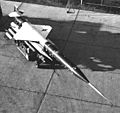Ramjet facts for kids
A ramjet is a special type of engine that uses the air around it to create a powerful push, called thrust. These engines are often found on aircraft. For a ramjet to work, the aircraft must be flying faster than the speed of sound, which is also known as Mach 1. Unlike regular aircraft engines, ramjets don't have moving parts to squeeze the air. Instead, they use powerful air waves called shock waves to compress the air.
Contents
How a Ramjet Works: Its Main Parts
A ramjet is made up of four important sections that work together.
Inlet: Catching and Squeezing the Air
The first section is called the inlet. Its main job is to capture air and squeeze it tightly. This squeezing, or compression, is needed so the fuel can burn correctly. The compression happens because of a shock wave. Shock waves only form when the aircraft is flying at or above Mach 1. This is why ramjets work best when flying very fast, usually around Mach 2 or 3.
Diffuser: Slowing Down the Air
The second part of the ramjet is the diffuser. The air coming through the inlet is moving incredibly fast. It's very hard to burn fuel when the air is moving so quickly. The diffuser's job is to slow this fast-moving air down smoothly. By the time the air has passed through the inlet, it is already traveling slower than Mach 1. This is important for the diffuser to do its job. The diffuser is basically a pipe that gets wider as the air moves through it. Because the air is moving slower than Mach 1, this increasing space causes the air to slow down even more.
Combustion Chamber: Burning the Fuel
The third part of the ramjet is the combustor, also known as the combustion chamber. This is where the fuel is mixed with the air and then burns. When the fuel burns, it adds a lot of energy to the air. This energy will later be used to create the thrust that pushes the ramjet forward. The air must be moving fairly slowly for the fuel to burn well. Inside the combustor, there's a part called the flame holder. As its name suggests, the flame holder keeps the flame burning steadily. A typical flame holder looks like a ring of small V-shaped metal pieces. These pieces create tiny areas of slow-moving air, which helps the fuel keep burning.
Nozzle: Creating the Push
After the fuel burns and the air gets very hot, it flows through the last part, which is the nozzle. The nozzle's purpose is to turn all the energy in the hot air into thrust. To do this, the nozzle first gets smaller and then gets larger. The smallest part of the nozzle is called the "throat." The air coming from the combustor is moving slower than Mach 1. So, as the nozzle gets smaller, the air speeds up. The nozzle is designed so that when the air reaches the throat, it has sped up all the way to Mach 1. This is a key detail for the nozzle to work correctly. Once the air passes the throat, the nozzle gets larger again. Since the air reached Mach 1 in the throat, increasing the area now makes the air speed up even more. This is how thrust is created. The air shooting out of the nozzle essentially "pushes" the ramjet forward.
Related pages
Images for kids
See also
 In Spanish: Estatorreactor para niños
In Spanish: Estatorreactor para niños





